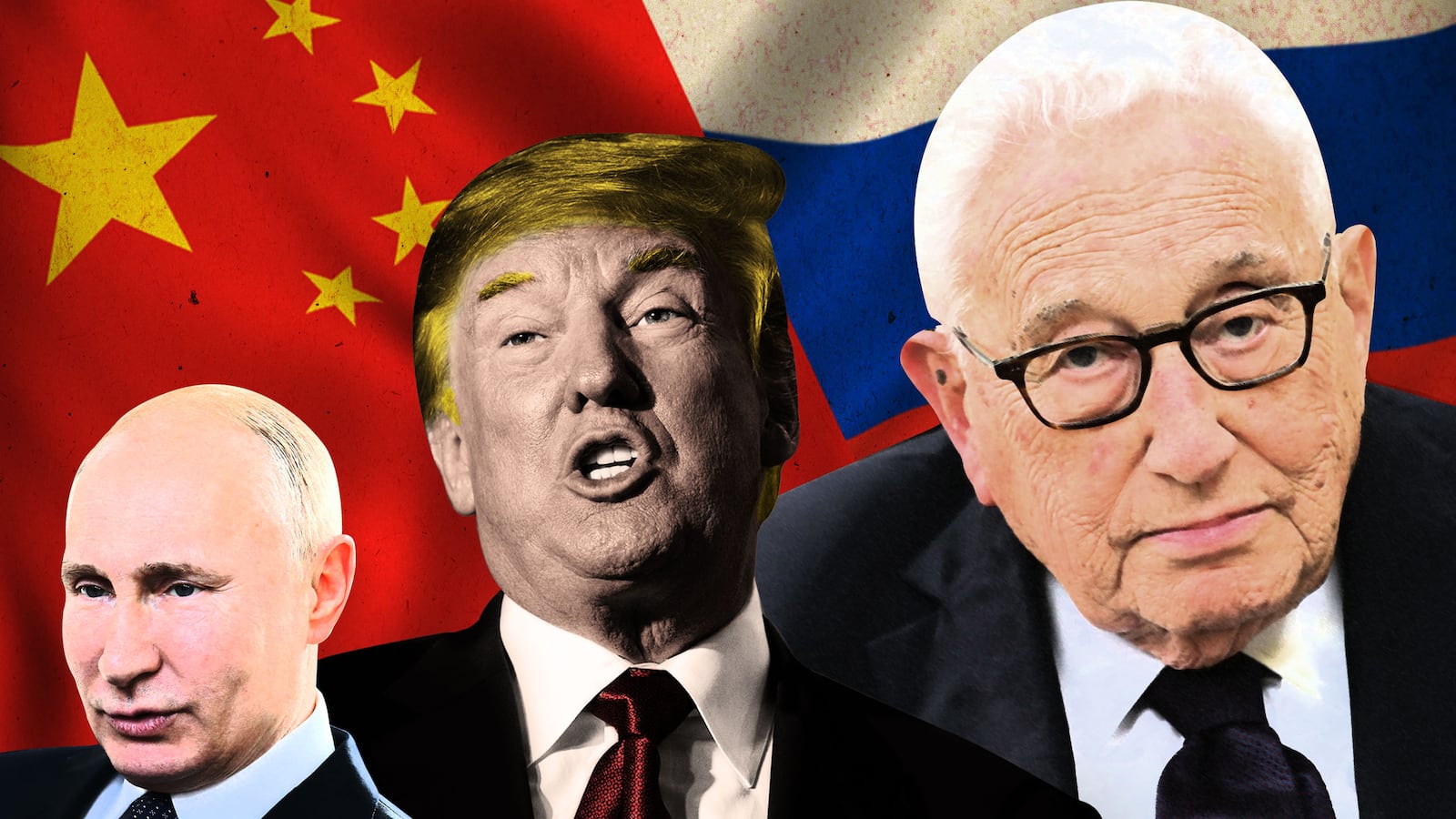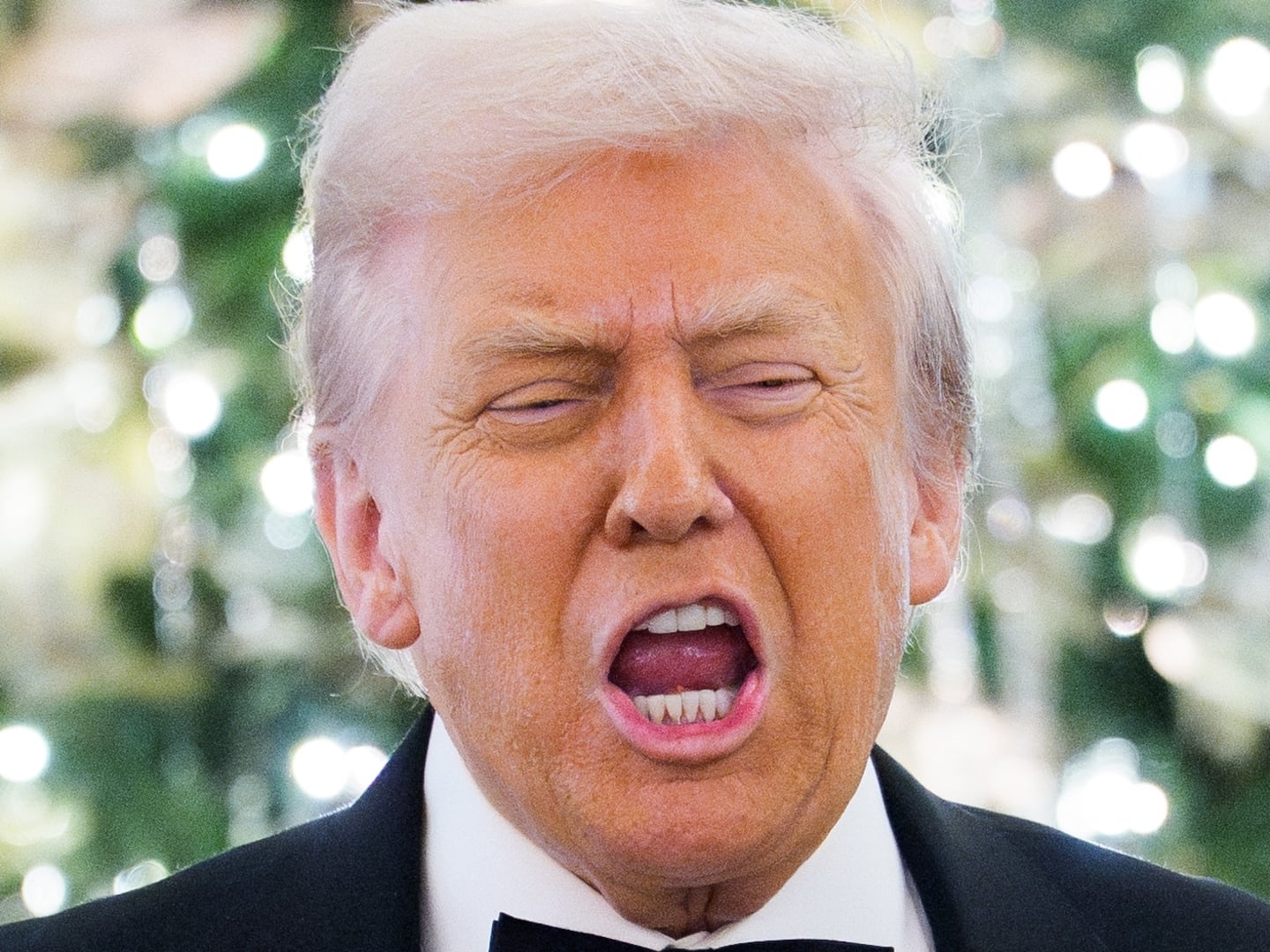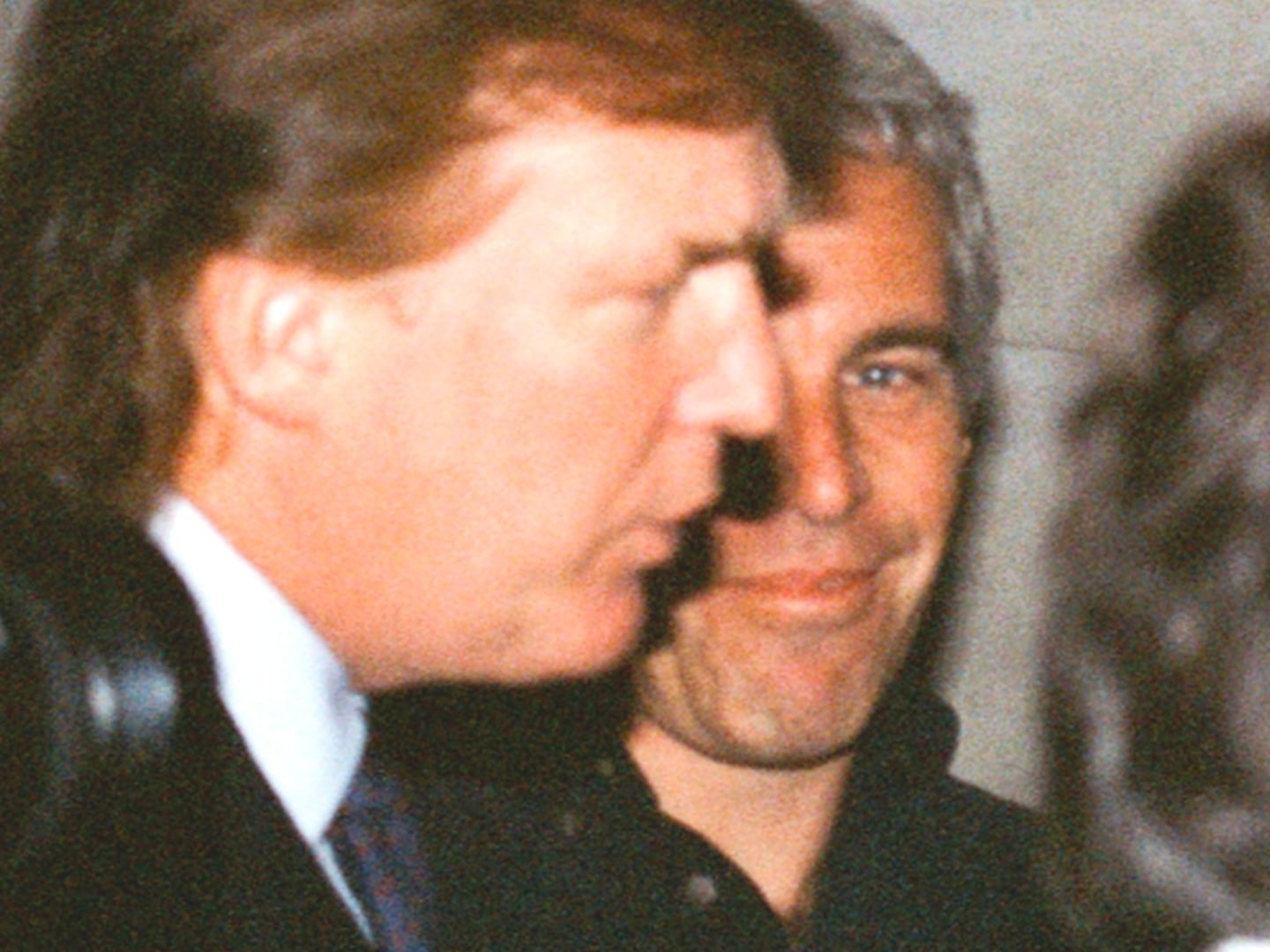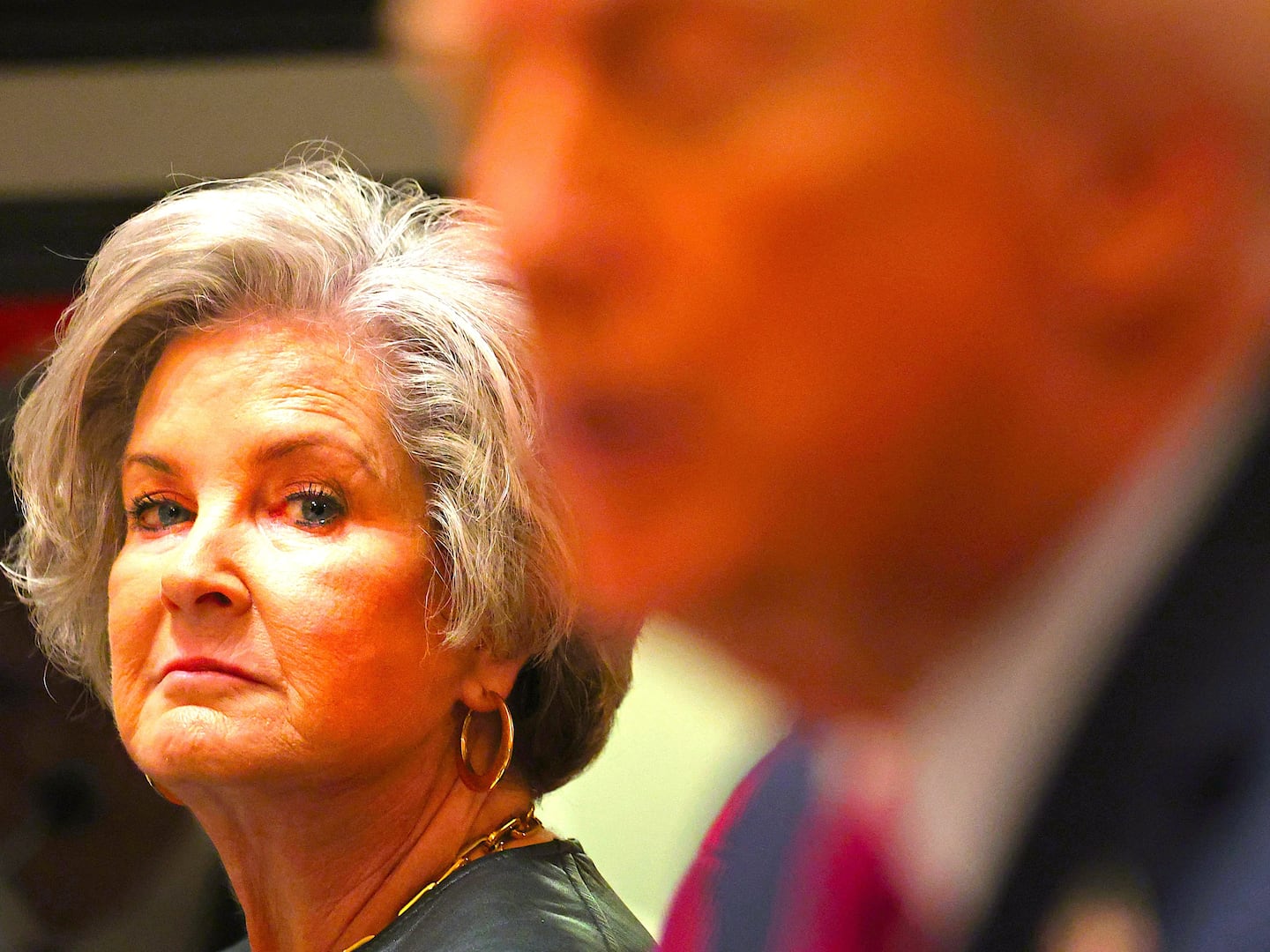Henry Kissinger suggested to President Donald Trump that the United States should work with Russia to contain a rising China.
The former secretary of state—who famously engineered the tactic of establishing diplomatic relations with China in order to isolate the Soviet Union—pitched almost the inverse of that idea to Trump during a series of private meetings during the presidential transition, five people familiar with the matter told The Daily Beast. The potential strategy would use closer relations with Russia, along with other countries in the region, to box in China’s growing power and influence.
Kissinger also pitched the idea to Jared Kushner, the top White House adviser whose portfolio includes foreign-policy matters, one of the sources briefed on the discussions said.
Inside the administration, the proposal has found receptive ears, with some of Trump’s top advisers—in addition to officials in the State Department, Pentagon, and the National Security Council—also floating a strategy of using closer relations with Moscow to contain Beijing, according to White House and Capitol Hill insiders. But the idea has been complicated by the president’s deference to Russian President Vladimir Putin, which has caused countless domestic political headaches.
Both the White House and the National Security Council declined to comment. Kissinger's office did not return a request for comment.
The mere fact that Kissinger was given an audience to make his pitch—he’s met with Trump at least three times since the 2016 campaign—is a testament to his tremendous staying power in top political circles, despite a controversial foreign policy track record that includes numerous accusations of war crimes. It also is a reflection of how dramatically geopolitical relations have changed during the course of his lifetime.

Kissinger isn’t viewed as a China hawk. It is well known in certain circles that he has a direct line to Chinese President Xi Jinping. And the discussions he had with Trump appear, at least superficially, to run counter to his public pronouncements since 2017 that China’s signature Belt and Road Initiative—Xi’s vision for a China-centric world based on infrastructure and trade deals, and the object of growing Western alarm—would have a positive effect on Asia.
Kissinger is no Russophobe, either. He has met with Putin 17 times over the years. And Kissinger has repeatedly advocated for a better working relationship between Washington and Moscow. Of last week’s summit in Helsinki between Trump and Putin, Kissinger said, “It was a meeting that had to take place. I have advocated it for several years.” He has also expressed doubt about the purpose of Russian interference in the election, and promoted a better balance of power among the world’s largest influencers.
His overall views seem to have made their way into explanations for Trump’s affinity for Putin. One former Trump administration official referred to Trump’s posture toward Putin during the Helsinki summit earlier this month as “the reverse of the Nixon-China play.”
“Russia and China are cozying up to each other and it’s a lethal combination if they’re together,” said the former official, who was familiar with the strategizing behind the summit.
During the 2016 presidential campaign, various figures in the Trump orbit—not just Kissinger—discussed a strategy of shoring up relations not only with Russia, but also with Japan, the Philippines, India, Middle Eastern countries, and others as a wide-ranging international counterweight to what was pitched as the dominant Chinese threat.
Since becoming president, Trump, those sources said, has shown varying signs of interest. But his actual posture toward China has remained difficult to define. The president has flattered the country’s political leadership, partnered with it on key foreign policy matters, and adopted highly confrontational positions on trade. Anything resembling a large, cohesive “counterweight” policy has yet to gain serious traction. And one of the main economic levers that would be used to achieve this type of outcome—the trade deal known as the Trans Pacific Partnership—was abandoned by Trump even as Kissinger himself nominally supported it.
Internally, the fights over a China policy have been lengthy. Steve Bannon, Trump’s former chief strategist, has long railed against a rising threat from China, and he was present during the meeting between Trump and Kissinger that took place during the transition. Other Trump allies who share Bannon’s hawkish disposition include trade adviser Peter Navarro, Sens. Marco Rubio (R-FL) and Tom Cotton (R-AR), and U.S. Trade Representative Robert Lighthizer.
Unlike Kissinger—who stressed that relations with Russia were not an end goal itself but part of a decades long approach to revamping continental power structures—these advisers argued that the threat from China needed to be confronted in the near term. A congressional source familiar with the strategy said Bannon often focused on “civilizational threats that face the U.S. emanating from Arab world and China.” Indeed, Bannon has backed populist, nationalist parties throughout Europe based in large part on appealing to identity politics and perceived international threats. Those same parties have often embraced and praised Putin.
Among Capitol Hill foreign policy circles, the source added, the view is that Kissinger’s motivations for pursuing the reverse of his own policy from the 1970s are “more intellectually honest and honorable” than Bannon’s. Though a separate source familiar with the transition talks said the two individuals had a fair amount of overlap in terms of their world views.
“[Kissinger] did not advocate a partnership with Russia,” said the source. “But he was absolutely adamant that 17 years of the global war on terror had taken up too much time and focus. And he is a huge believer that this is a great power struggle [with China].”

The issue for lawmakers, as is often the case with Trump, has been trying to discern whether his attempts to cozy up to Russia are driven by broader concerns about Beijing’s growing influence, or by an affinity for Putin himself.
That certainly has been the case in the wake of the Helsinki summit, during which Trump sided with Putin’s denials of Russian election meddling over the assessment of his own intelligence agencies.
The episode prompted sharp criticism from lawmakers, including some who said that any talk of strategically working with Putin to combat China is merely a face-saving measure to explain away the president’s conduct. But according to Capitol Hill sources, it also left several lawmakers wondering whether the administration was attempting to make a larger move on China.
“I’m hesitant to characterize what is being legitimately discussed because this administration is such an incoherent dumpster fire it’s impossible to ascertain what’s legitimate discussion, what’s not legitimate, what’s being discussed in one part but may have no traction elsewhere,” a source on Capitol Hill said.
Trump advisers have considered the Kissinger-type approach to east Asia since the 2016 campaign. But a source close to the White House noted that the “key word is ‘considering’ as they know that any move to implement it would, at least currently, be met with a massive backlash, and rightly so.”
The source added that several senior White House officials believe that “Russia would be a ‘useful counterweight’ to China.” But not everyone buys into that theory.
It’s not just that Russia has played a largely counter-productive role vis-a-vis the United States, and much of the rest of the liberal world order, over the last few years. It’s that their points of leverage over China are limited largely to weapons, oil, and cyber intrusions.
“I understand the idea of a collective approach to boxing China in and trying to integrate it into an order consistent with our interests,” said Richard Haass, president of the Council on Foreign Relations. “I just don’t see Russia as currently oriented playing a role in that.”
Still, U.S. officials have become increasingly vocal in their warnings of the threat that China poses and the need for a comprehensive strategy to combat it. At the Aspen Security Forum last week, FBI Director Christopher Wray called China “the broadest, most challenging, most significant threat we face as a country,” and Michael Collins, deputy assistant director of the CIA’s East Asia mission, said that China is waging a “cold war” against the United States.
“It is clear the Trump administration views the rise of China—from issues of trade, its continued quest to dominate Asia and displace U.S. power to building a military that can challenge Washington’s most advanced weaponry—as its number one national security challenge,” said Harry Kazianis, director of defense studies at the Center for the National Interest. “I am not shocked that they would consider Russia a potential partner in containing China’s rise.”

In theory, the partner-with-Russia-to-combat-China strategy—regardless of its motivations—is not entirely without merit, experts say, if only to break up the partnership developing between Presidents Putin and Xi themselves.
“China and Russia have a very similar worldview right now and they're supporting each other pretty strongly. I don’t see a lot of cracks,” said Lyle Goldstein, a Russia and China expert at the U.S. Naval War College.
Russia and China often pursue complementary agendas and support each other at the United Nations Security Council, said Abigail Grace, who until recently worked on the Asia portfolio at the National Security Council. “I don’t think that the level of China-Russia collaboration is necessarily within U.S. interests,” Grace said.
But while Moscow and Beijing have cordial relations and share many strategic objectives, there are areas of relative distrust between them, including over Central Asia. China has made major economic and diplomatic inroads in the region with its Belt and Road Initiative, which includes Central Asian nations as a key part of its strategy. But Russia views that region as within its traditional sphere of influence. While it hasn’t stood in the way of Xi’s overtures to countries like Kazakhstan and Uzbekistan, it has declined to join the initiative despite China’s invitation.
Beyond Central Asia, it’s also clear that with its enormous economy and rapidly expanding military ambitions, China is on a trajectory to greatly surpass Russia’s global heft—a trajectory that could compel Russia to seek partnerships (informal or otherwise) elsewhere.
“Looking out over long term, there is a belief in the administration that Moscow will see Beijing as its greatest geopolitical foe—just like Washington does now—and that could set up a rapprochement with America,” said a source close to the White House. “But it is very far out into the future.”
But there’s a very good reason the “reverse Nixon” strategy hasn’t been implemented yet. It’s just not geopolitically realistic.
“China is the greater long term strategic challenge,” said John Rood, the under secretary of defense for policy, at the Aspen Security Forum. “But in many ways, Russia is the larger near term threat because of the overwhelming lethality of its nuclear arsenal and also because of some of the behavior that the Russian government has exhibited.”
Russia is at times a flamboyant foe of the European Union and the United States, seeking to sow disruption and division within and among Western allies. It also has been a highly disruptive force in U.S. politics, making it an illogical partner for an ambitious attempt to help preserve the current international system.
“At the moment, with Russia having tried to attack our democratic institutions as well as still acting like a rogue state in Ukraine and Syria, the chances of a U.S.-Russia alliance to take on China are slim to none,” said Kazianis.
“But know this: time and circumstance can change minds and win hearts. I would not be shocked if in seven to 10 years this does indeed take place.”
—with additional reporting by Kim Dozier









